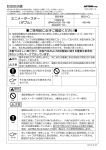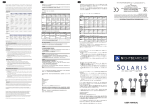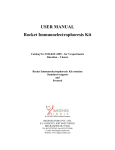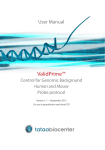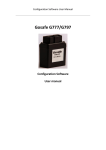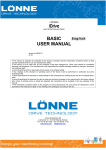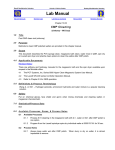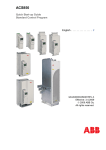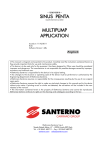Download LAURELL 650M SPIN COATER USER MANUAL
Transcript
LAURELL 650M SPIN COATER USER MANUAL (Can spin up to 6” wafers or 5"x5" samples at 12,00rpm max) A -‐ KEYPAD All operator actions are initiated through the membrane switch keypad, figure 3-‐5. B -‐ RUNNING THE SPIN COATER 1. Press “SELECT PROCESS” key 2. Press “RUN MODE” key to enter a selected program. 3. Open the lid. Check the o-‐ring for any damage or chemical build up. Ensure that there is no chemical beyond the o-‐ring going into the vacuum path. If necessary, wet a cleanroom wipe with IPA and gently clean the o-‐ring. DO NOT SPRAY CHEMICALS ANYWHERE NEAR THE SPIN COATER! Place and align a substrate on the chuck (for wafers, use the align tool). Press the “VACUUM” key to activate the vacuum valve. ***YOUR SAMPLES MUST COMPLETELY COVER THE O-‐RING*** USE THIS CHUCK FOR SAMPLES 2”-‐ 6” IN DIAMETER. USE THIS ADAPTER CHUCK FOR SMALLER SAMPLES (LIKE GLASS SLIDES). 4. Close the lid. 5. Press “START” key to start a program. The program will not start until the vacuum hold down requirement is met, the seal purge requirement is satisfied, exhaust flow is correct if needed and the lid is closed. The program will stop automatically if the lid is opened, or the N2 motor seal purge is not satisfied (<60 PSI), or exhaust drops or increases beyond the set point or the vacuum requirement for hold down is not maintained. The remaining process time will be maintained. 6. “Done” will be displayed when the process is completed and the lid has not yet been opened for wafer removal. Restarting the same sequence on the same wafer is not allowed until the lid is opened or the “EDIT” key is pressed then the “RUN” key. 7. Clean up after yourself (see cleaning section on the last page). PLEASE NOTE -‐ Regarding Vacuum Chucks: Maximum spin speed is dependent on substrate size, shape and weight in conjunction with chuck diameter (vacuum holding area) and weight. All substrates, regardless of size or shape, MUST BE CENTERED ON THE VACUUM CHUCK. Off-‐centered substrates will cause vibration at high spin speeds and may cause a loss of vacuum. Examples: ·∙A small fragment may be able to spin up to 12krpm if the proper sized fragment adapter is used. ·∙A 100mm – 150mm wafer should be limited to ~6krpm if a small chuck is used. The same size wafers may be spun faster if the chuck is the same diameter as the wafer. ·∙200 – 300mm wafer depending on chuck size should be limited to 2.5 – 3.5krpm (if smaller than wafer). C – PROGRAMMING THE SPIN COATER 1. Turn on the spin processor. The 650 will initialize and default to the “Select Process” screen. 2. If editing an existing program, highlight the desired program. If creating a new program highlight the empty line. Press the “Edit Mode” key. If this is a new program a program name will be assigned. The program name will appear on the title line. 3. Use the navigation keys to move from line-‐to-‐line or the “tab<” or “tab>” key to move to field-‐to-‐ field. The “TAB” key enables the field to be editable. Make changes to the field by using the “UP” or “DOWN” arrow keys. 4. Add or delete steps by highlighting the “steps” field with the “Tab” key and increase or decrease the number. 5. Move from step-‐to-‐step by using the “FWD” or “REV” keys. 8. When finished press the “Run Mode” key to run the program. Example Program: D – CLEANING THE SPIN COATER 1. Cover the vacuum chuck with a dummy sample or plastic blank provided (clear, plastic 2” disk). Again, be sure the sample completely covers the o-‐ring. 2. Wet a cleanroom wipe with acetone and wipe out the chamber – be sure to get all of the photoresist out. If you spilled any photoresist on the outside chamber, lid, or display -‐ wipe them off as well. Dispose of the wipes in the appropriate waste container. 3. Dry out the chamber with dry cleanroom wipe. CAUTION! 1. The vacuum path is not designed for any pressure. Air pressure or any liquid forced or drawn into the vacuum chuck will very likely damage the vacuum sensor, seals, motor and electronics. This type of damage is not covered by our warranty! 2. DO NOT FLOOD THE AREA BETWEEN THE STATIONARY SEAL AND THE ROTATING SEAL. THIS CAN CAUSE MOTOR OR ELECTRONICS DAMAGE. (See Fig. 4-‐1) 3. Care should be taken not to flood the process chamber during cleaning. 4. It is VERY important not to allow chemicals or chemical cleaners to enter the vacuum path. 5. NEVER flood or spray solvent such as acetone or any other type of cleaner directly onto the keypad surface. DOING SO MAY CAUSE KEYPAD FAILURE! Always wet a wipe or cloth with the solvent and gently wipe the keypad surface.






